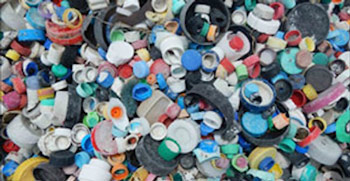From Beaches to the Bottom of the Sea, Microplastics Everywhere
Reproduction, Feeding in Marine Species Can be Affected

This photo, taken after a 21-day marine debris removal effort by the Pacific Island Fisheries Service Coral Reef Ecosystem Division, shows 4,781 bottle caps collected from Midway Atoll’s shoreline. Most plastic bottle caps are made from polypropylene, also known as plastic #5, a hard, durable plastic that can be difficult to recycle in some municipalities.
Each year, millions of tons of pastic debris, from water bottles to fishing nets, plastic bags and anything else made of plastic, enters the ocean as marine debris through beach littering, road runoff, sewage, and illegal dumping.
Microplastics, defined as pieces of plastic less than 5 millimeters in size (less than 1/5th of an inch), are everywhere – in the sediments and in the water column, on beaches and in the deep sea. Some microplastics are manufactured at that small size as microbeads for use in cosmetics, toothpaste and facial scrubs, or made as microfibers in synthetic items such as fleece or rope. Others come from larger pieces of plastic that are broken down over time by waves and sunlight into smaller fragments.
Marine animals, from shellfish and fish to larger marine mammals, ingest them through the water or eat prey that contains them. The impact can be serious, affecting an animal's feeding and reproduction.
Chemists Ashok Deshpande and Beth Sharack of the NEFSC’s Sandy Hook Lab study the impact of chemicals in the marine environment, using analytical tools like gas chromatography and mass spectrometry, commonly known as GC/MS, to look much more closely at the chemical components of plastic pollution. It’s a detective story, as they identify different types of polymers, how they change over time, and where they may have come before they are found in fish and shellfish and in marine sediments.
Their latest tool adds pyrolysis to GC/MS, a technique known as Pyr-GC/MS. In simple terms, a very small piece of plastic, or microplastic, less than 1 milligram in size is placed in a narrow quartz tube which is then placed in a platinum coil and heated to 750 degrees C (about 1,382 degrees F). The intense heat breaks down the large polymer chain into smaller fragments which are then analyzed by the GS/MS to identify the specific chemicals and contaminants in that sample – a chemical fingerprint of sorts.
“Information on polymer chemistry will help identify plastic products and perhaps help in the mitigation, control, and monitoring of the status and trends of plastic pollution,” said Deshpande, a research chemist in the Habitat Ecology Branch at the Sandy Hook Lab. “Different polymers, which are large molecules made up of many smaller molecules or monomers, have different toxicities and adsorb or bind contaminants in different ways."
Deshpande said marine animals exposed to microplastics are subjected to a triple threat. "There is the toxicity of the plastic polymer itself, toxicity of the contaminants adsorbed on the plastics, and the nutritional challenge due to the consumption of plastics with literally no food value. It is an area of concern in the management of fisheries resources and endangered species. Some scientists refer to plastics as the next wildlife predator due to their potential behavioral, morphological, physiological, and life cycle effects on wildlife."
Deshpande, Sharack and colleagues have developed a baseline library of the pyrolysis GC/MS spectra – the chemical fingerprints – from commonly used plastic polymers. They are currently testing the proof of concept of this novel method by analyzing routine plastic items used in our daily lives and the broken pieces of plastics from field collections. The results so far are encouraging.
Understanding what the microplastic pollution is made of, where it is being found and how it is affecting marine species and their habitats will help improve fisheries and habitat management.
